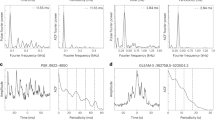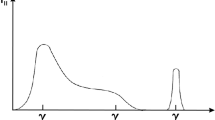Abstract
Pulsars are magnetized neutron stars. They are not resolved by modern radio telescopes and are studied only by radiation coming from the regions of the magnetic poles. Because of the rotation, this narrow radiation is received as pulses. In a few pulsars whose magnetic axis is almost orthogonal to the rotation axis (the simplest hypothesis), pulses are observed from both poles: the (main) pulse and the interpulse. Such objects primarily include a pulsar in the Crab nebula, observed at many frequencies of the electromagnetic spectrum. In the remarkable work of Hankins and Eilek, a striking difference between the spectra of the main pulse and the interpulse in the Crab nebula in the centimeter wavelength range at microsecond resolution was found (surprising the authors: “In traditional pulsar models... the MP and IP should be the same in their observable quantities (such as spectrum, time signature, or dispersion). We were—and remain—quite surprised that this turns out not to be the case in the Crab pulsar.” See T. H. Hankins and J. A. Eilek, “Radio emission signatures in the Crab pulsar,” Astrophys. J., 670:693–701, 2007). In particular, a wide range of frequencies was observed in the spectra of the main pulse forming “vertical structures,” while “horizontal structures” with distinguished frequencies were observed in the spectra of the interpulse at the same frequencies. Such a difference, related to different radiation mechanisms (nonrelativistic electron emission in a longitudinal accelerating field for the main pulse and relativistic positron radiation due to the curvature of magnetic field lines for the interpulse), is explained by the change from the nonrelativistic to the relativistic mechanism as the frequency increases. Therefore, the frequencies at which the mechanism changes differ for the main pulse and the interpulse. The frequency of observation in the work of Hankins and Eilek is just between these frequencies with which the difference in the microstructure is connected.
Similar content being viewed by others
References
F. G. Smith, Pulsars, Cambridge Univ. Press, Cambridge (1977).
V. M. Lipunov, Astrophysics of Neutron Stars [in Russian], Nauka, Moscow (1987); English transl., Springer, Heidelberg (1992).
V. S. Beskin, MHD Flows in Compact Astrophysical Objects, Springer, Berlin (2010).
P. Haensel, A. Yu. Potekhin, and D. G. Yakovlev, Neutron Stars 1 (Astrophys. Space Sci. Libr., Vol. 326), Springer, New York (2007).
A. Yu. Potekhin, “The physics of neutron stars,” Phys. Usp., 53, 1235–1256 (2010).
D. Moffett and T. Hankins, “Multifrequency radio observations of the Crab pulsar,” Astrophys. J., 468, 779–783 (1996); arXiv:astro-ph/9604163v1 (1996).
T. H. Hankins, G. Jones, and J. A. Eilek, “The Crab pulsar at centimeter wavelengths: I. Ensemble characteristics,” Astrophys. J., 802, 130 (2015).
V. M. Kontorovich and S. V. Trofymenko, “On the mystery of the interpulse shift in the Crab pulsar,” J. Phys. Sci. Appl., 7, 11–28 (2017); arXiv:1707.01584v3 [astro-ph.HE] (2017).
V. M. Kontorovich, “Nonlinear reflection from the surface of a neutron stars and features of radio emission from the pulsar in the Crab nebula,” Low. Temp. Phys., 42, 672–678 (2016).
A. N. Timokhin and J. Arons, “Current flow and pair creation at low altitude in rotation powered pulsars’ force-free magnetospheres: Space-charge limited flow,” Mon. Not. Roy. Astron. Soc., 429, 20–54 (2013); arXiv:1206.5819v2 [astro-ph.HE] (2012).
A. N. Timokhin and A. K. Harding, “On the polar cap cascade pair multiplicity of young pulsars,” J. Astrophys., 810, 144 (2015).
W. M. Fawley, J. Arons, and E. T. Scharlemann, “Potential drops above pulsar polar caps: Acceleration of nonneutral beams from the stellar surface,” Astrophys. J., 217, 227–243 (1977).
V. B. Berestetskii, E. M. Lifshitz, and L. P. Pitaevskii, Course of Theoretical Physics [in Russian], Vol. 4, Quantum Electrodynamics, Nauka, Moscow (1989); English transl. prev. ed., Pergamon, New York (1982).
T. Erber, “High-energy electromagnetic conversion processes in intense magnetic fields,” Rev. Modern Phys., 38, 626–659 (1966).
S. Shibata, J. Miyazaki, and F. Takahara, “On the electric field screening by electron–positron pairs in the pulsar magnetosphere II,” Mon. Not. R. Astron. Soc., 336, 233–242 (2002).
V. M. Kontorovich and A. B. Flanchik, “High-frequency cutoff and change of radio emission mechanism in pulsars,” Astrophys. Space Sci., 345, 169–175 (2013); arXiv:1201.0261v4 [astro-ph.SR] (2012).
J. D. Jackson, Classical Electrodynamics, Wiley, New York (1999).
L. D. Landau and E. M. Lifshitz, A Course of Theoretical Physics [in Russian], Vol. 2, The Classical Theory of Fields, Nauka, Moscow (1967); English transl., Pergamon, Oxford (1971).
V. M. Kontorovich and A. B. Flanchik, “Correlation of pulsar radio emission spectrum with peculiarities of particle acceleration in a polar gap,” JETP, 116, 80–86 (2013); arXiv:1210.2858v1 [astro-ph.SR] (2012).
T. H. Hankins and J. A. Eilek, “Radio emission signatures in the Crab pulsar,” Astrophys. J., 670, 693–701 (2007).
T. H. Hankins, J. S. Kern, J. C. Weatherall, and J. A. Eilek, “Nanosecond radio bursts from strong plasma turbulence in the Crab pulsar,” Nature, 422, 141–143 (2003).
J. Eilek and T. Hankins, “Radio emission physics in the Crab pulsar,” J. Plasma Phys., 82, 635820302 (2016).
V. V. Zheleznyakov, V. V. Zaitsev, and E. Ya. Zlotnik, “On the analogy between the zebra patterns in radio emission from the sun and the Crab pulsar,” Astron. Lett., 38, 589–604 (2012).
V. A. Soglasnov, M. V. Popov, N. Bartel, W. Cannon, A. Yu. Novikov, V. I. Kondratiev, and V. I. Altunin, “Giant pulses from PSR B1937+21 with widths ≤ 15 nanoseconds and Tb ≥ 5 × 1039 K, the highest brightness temperature observed in the Universe,” Astrophys. J., 616, 439–451 (2004); arXiv:astro-ph/0408285v1 (2004).
V. M. Kontorovich, “Giant pulses from pulsars [in Russian],” Problems of Atomic Science and Technology, 4, No. 68, 143–148 (2010).
V. M. Kontorovich, “On high brightness temperature of pulsar giant pulses,” J. Phys. Sci. Appl., 5, 48–60 (2015).
V. M. Kontorovich, “Quantization of an electromagnetic tornado and the origin of bands in the spectrum of giant pulses from the Crab pulsar,” Astronomy Lett., 40, 793–799 (2014).
R. C. Davidson, Theory of Nonneutral Plasmas, W. A. Benjamin, Reading, Mass. (1974).
V. M. Kontorovich, “Electromagnetic tornado in the vacuum gap of a pulsar,” JETP, 110, 966–972 (2010).
Author information
Authors and Affiliations
Corresponding author
Ethics declarations
The author declares no conflicts of interest.
Additional information
__________
Translated from Teoreticheskaya i Matematicheskaya Fizika, Vol. 202, No. 3, pp. 447–457, March, 2020.
Rights and permissions
About this article
Cite this article
Kontorovich, V.M. Why do the microstructures of the main pulse and the interpulse of the pulsar in the Crab nebula differ so dramatically?. Theor Math Phys 202, 390–398 (2020). https://doi.org/10.1134/S0040577920030113
Received:
Revised:
Accepted:
Published:
Issue Date:
DOI: https://doi.org/10.1134/S0040577920030113




